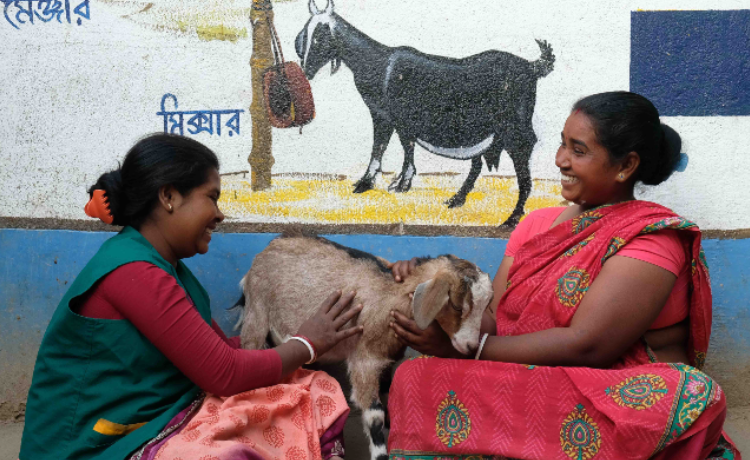Sourav Mukherjee is a key driver of the goat based livelihood, and women empowerment programs for Ambuja Foundation in Farakka West Bengal. To say the least, this man is passionate about goats – having seen first-hand how goats have the ability to lift families directly out of poverty – and has no problem talking your ear off on the subject when you show even the slightest bit of curiosity.
“In Farakka, West Bengal, goats are commonly referred to as the ‘poor man’s bank.’” Sourav says. Why? “Goats can be bought and reared with very low investment compared to cattle and buffalo. You can also sell them quickly when you need cash. They are profilic breeders – often giving birth to twin kids – which is a boon for marginal or BPL families.” He says.
Acting as a supplementary livelihood, goats have multiple uses in the lives of the poor—as food, as a means to access cash in emergencies, as a source of income and as part of religious rituals. But despite the fact that India has the second largest goat population in the world (with over 140million goats), the humble goat has received little recognition for the crucial role it plays in poverty eradication - largely kept and managed by women and poor families, whose political voice is negligible and who are mostly unorganized.
Sourav and his team, along with Ambuja Foundation teams across 3 locations of Rajasthan, Chandrapur and Bhatapara, Farakka, Mundwa, Raigarh and Sankrail are changing all that – promoting a robust grassroots Goat Based Livelihoods Program which over the past 4 years has transformed lives.
“In 2015- 16, we surveyed 3 villages in a 5km radius and realised that almost 200 goats were dying every year, due to goat diseases in each village. Now every goat has a selling price of approximately Rs.8000-10,000, so if 200 goats die in a village then the loss is between Rs. 16-20 lakhs! This was a massive financial hit for largely tribal, marginal small landholders to absorb. So we decided to get to work and do something about it.” Sourav said.
“Firstly, we mapped all the problems – the seasonal bacterial diseases that the goats faced like Goat pox (PPR), Tetanus, Tetanus toxide, FMD (Food and Mouth diseases), etc. that cause goat deaths; the fact that there were no special services to take care of goats; the lack of awareness about these diseases and goat rearing practices among goat owners. The fact that goats faced genetic issues which resulted in poor health; owners had no insurance policy against the loss of a goat.” He said.
“Considering all these problems, we designed a program where are objectives were to: decrease goat mortality rates; educate people about the proper growth of the goats; instil scientific management practices; and increase income for goat owners.” He said.
Goats are largely kept and managed by women and poor families, whose ‘voice’ is negligible and who are vastly unorganized. And goat-rearers are usually poor, illiterate and marginalized. Hence a crucial part of the Ambuja Foundation program approach is the establishment of people’s institutions like Goat Based Livelihood Groups (GBLG) to provide peer learning and support.
“From these groups we developed a community cadre of women who we called Pashu Sakhis – training them as para vets for the goats and collaborating with the Government also.” Sourav said. “Along with Pashu Sakhis, there were CLF (Community Livestock Facilitators) who could provide proper treatment to the goats across various villages and the cadre of people also supported them.” He said.
“We started addressing each of the issues people were facing in a systematic way and it was incredible to see how things slowly turned around.” He said.
The 3 important changes over the past 6 years were:
Goat mortality rate is zero - Disease related deaths are zero and if there are any deaths they are accidental deaths. Earlier, in a village there were 200 – 300 disease related goat deaths annually.
Goat growth has increased – Before Ambuja Foundation’s intervention, the fodder management capacity in the village was not up to the mark. People used to leave the goats to search for fodder in the surroundings, but now everyone has started fodder management - cultivating fodder at their home. Women from the GBL groups started making nutritious food for the goats. Today women from all households prepare this nutritious food based on 10-12 components like paddy, bhutta, gur and mineral wheat.
Growth in Herd Numbers & Profits - The Pashu Sakhis monitored the amount of weight gained by the goats and along with weight gain we also noticed changes in their growth. Due to this there was increase in the income growth of the women. In 2016 women used to have only 1 or 2 goats and stopped keeping goats as they would suffer losses due to their deaths. But today women have 8 to 10 goats and if we calculate the value for 1 goat as Rs. 10,000 then their stock is worth Rs. 80,000. And thus there is improvement in the Income rate of the women and this has become our main focus.
However always looking for increased results, the project team have gone the extra mile in a number of areas. “For the first time in West Bengal we have organised 300 tribal women registered a Goat based FPC (Farmer Producer Company). The share capital of these women is approximately 1.6 Lakhs and it’s been 6 months, since they have made a business of 8 Lakhs".
A ‘Goat Bank’ service was kickstarted in Farakka, to provide all goat related services and materials together in a ‘one stop shop’ for people. And the team is seeking certification to sell goat manure, and is exploring the collective marketing and processing of mutton to export abroad, which provides great profits.
Summary
With the fragmentation of family land holding and erratic rainfall, most marginal land-holding families find solace in goat-farming. Acting as a coping mechanism, for the supplementary income it provides, and as a risk mitigation strategy for times of drought or excessive rainfall, which impacts crops, goats are the ‘poor man’s choice’ in the struggle against poverty - despite widespread apathy shown to this sector by mainstream institutions.
However development sector workers are realizing the importance of goats in the socio-economic context, despite limited attention paid to promoting it as a means to enhance productivity and strengthen livelihoods at a larger level. Much more work needs to be done to bring this sector to the fore as a low cost mechanism to help lift India’s rural poor out of poverty.


.png)




0 Comment